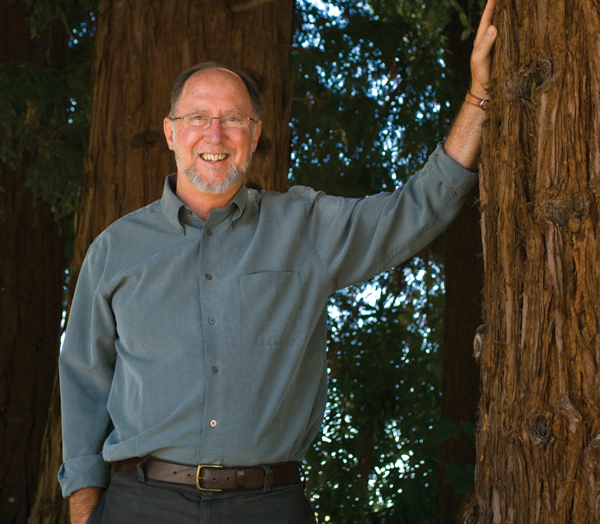Nowadays Reed Holderman dedicates his time to the conservation of trees and their habitats, specifically the Coast Redwood. That’s because he’s been the executive director of the Sempervirens Fund since 2009. One of the oldest conservation organizations in the United States, Sempervirens has been preserving the redwood forests of the Santa Cruz Mountains since 1901. Holderman’s not quite that old, but he’s been working for the conservation of nature and open space for more than three decades. I spoke with Holderman this week about his life and his work.
BN: Did you grow up in the Bay Area?
Holderman: I’m a transplant. I grew up in L.A., went to graduate school in Santa Barbara and came to the Bay Area in 1979 to take a job at the California Coastal Commission. Now I’ve been here for more than 34 years.
BN: How did you become a conservationist?
Holderman: As an undergraduate I studied history, planning to go into law afterwards. But then in graduate school, I studied environmental history, part of a new program at UC Santa Barbara in Public History, which emphasized work outside academia and in the real world. Much later I went back to graduate school in physical geography and became a visiting scholar at UC Davis in environmental studies in 1998.
In 1978 I got a job as a naturalist in the Los Padres National Forest in Central California. Plus, with my background in public history, I was able to research mysteries like why an area of grassland had appeared amid chaparral. This was a feature of the landscape no one could understand, and the administration needed someone to explain it. It turns out there had been a ranger there in the 1950’s who believed that grass held more water, so planting grass would “enhance the water retention capacity of the forest.” That strategy didn’t work, but years later someone had to explain what had happened – and why the grassland was there.
BN: What is the Sempervirens Fund?
Sempervirens is one of the oldest conservation organizations in the country—we’ve been around for 112 years. Our mission is to preserve redwood forest in the Santa Cruz Mountains. We do that in a number of ways – by buying land from willing sellers, purchasing development rights, purchasing timber rights, and accepting land donations. [Ed: To date. they’ve preserved 34.000 acres.]
BN: What are some of the organization’s recent successes?
Holderman: Along with four other organizations, we purchased the largest remaining single parcel of private property in the Santa Cruz Mountains, the [8,532-acre] CEMEX Redwoods. Since the parcel adjoined already-protected properties, this purchase resulted in connecting more than 26,000 acres of protected land, with CEMEX as the centerpiece.
We also established a conservation easement over 412 acres of Girl Scout camp property in the Santa Cruz Mountains. The Girl Scouts were having financial difficulties and wanted to sell the property. We convinced them not to sell the land and to instead sell us the development rights, so they could continue running the camps and providing environmental education programs to young people, but wouldn’t be able cut down the trees or subdivide the land.
BN: What challenges do you face making these kinds of deals?
Holderman: The challenge is always raising the money. With the economy suffering, there are a lot of opportunities for us, in terms of willing sellers of property. Unfortunately, the cash supply doesn’t match the opportunities.
With the CEMEX purchase, we were able to accomplish things that we couldn’t otherwise by working with other organizations. The CEMEX transaction was a thirty million dollar sale that needed to be completed in three months. The land owner said it had to be done by the end of the calendar year, so we were highly motivated and different organizations took on different jobs: performing land assessment, practicing title due dilligence, developing a conservation plan, working on the conservation easement… We were constantly on the phone, and emails were flying, but it got done.
The trend among conservation organizations these days is all about collaboration. Collaboration is great, but it poses a challenge on the front end: The more people in the room, the more complicated it gets, with diverse focuses, strategies and organizational identities. Learning to share is an important part of making collaboration work.
BN: Any other interesting work being done by Sempervirens?
Holderman: We’re committed to making sure that State Parks regain their stature and leadership role in California. A recent headline about us in the local paper reads, CASTLE ROCK COULD GET THE ROYAL TREATMENT. That’s because we’re investing four million dollars to move the entrance and provide amenities at Castle Rock State Park. We are building a new entrance on property right next to the park that we now own. It’s not all about buying protected forest; it’s about being able to get there, too.
BN: What is your favorite outdoor destination in the Bay Area?
Holderman: My favorite? I like the mountain bike ride around the ridge tops overlooking Lake Chabot. It’s like backpacking on a bike, and pretty special.
My favorite place to camp and hike is along the “Skyline to the Sea Trail,” which is a 31-mile hiking trial that goes from the top of the watershed at Castle Rock State Park, through Big Basin, and ends at the ocean at Waddell Beach. Incredible. You pass by one of the Bay Area’s most spectacular waterfalls—Berry Creek Falls—and walk through groves of giant and ancient redwoods that look like a giant box of tinker toys.
>> Learn more about the Sempervirens Fund and its work at: http://sempervirens.org/





